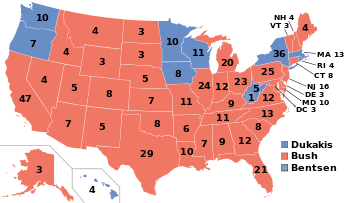United States presidential election in Texas, 1988
| | ||||||||||||||||||||||||||||||||
| ||||||||||||||||||||||||||||||||
| ||||||||||||||||||||||||||||||||
|
| ||||||||||||||||||||||||||||||||
| County Results
Dukakis—80-90%
Dukakis—70-80%
Dukakis—60-70%
Dukakis—50-60%
Dukakis—<50%
Bush—<50%
Bush—50-60%
Bush—60-70%
Bush—70-80%
Bush—80-90% | ||||||||||||||||||||||||||||||||
| ||||||||||||||||||||||||||||||||
The 1988 United States presidential election in Texas took place on November 8, 1988. All 50 states and the District of Columbia, were part of the 1988 United States presidential election. Texas voters chose 29 electors to the Electoral College, which selected the President and Vice President.
Texas was won by incumbent United States Vice President George H. W. Bush of Texas, who was running against Massachusetts Governor Michael Dukakis. Bush ran with Indiana Senator Dan Quayle as Vice President, and Dukakis ran with Texas Senator Lloyd Bentsen.
Texas weighed in for this election as 2% more Republican than the national average.
Partisan background

The presidential election of 1988 was a very partisan election for Texas, with more than 99% of the electorate voting for either the Democratic or Republican parties.[1] This is one of the last elections in Texas where you see many rural counties (including a large Democratic stronghold along the border with Louisiana) voting for the Democratic Party, and the populated counties, such as Houston's Harris County, voting mainly for the Republican candidate. Since the Presidential election of 1996, this demographic trend in Texas has reversed to its current form of 'urban Democrats' and 'rural Republicans' in the state of Texas, and elsewhere in the United States.
Republican victory
Bush won his home-state with a solid 12 point landslide. This election marks one of the first times that Texas has proven (post Reagan) to be a reliable Republican vote, and a decisively large player in Southern politics. The election results in Texas are also reflective of a nationwide reconsolidation of base for the Republican Party, which took place through the 1980s. Through the passage of some very controversial economic programs, spearheaded by then President Ronald Reagan (called, collectively, "Reaganomics"), the mid-to-late 1980s saw a period of economic growth and stability. The hallmark for Reaganomics was, in part, the wide-scale deregulation of corporate interests, and tax cuts for the wealthy.[2]
Dukakis ran his campaign on a notably socially liberal agenda, and advocated for higher economic regulation and environmental protection. Bush, alternatively, ran on a campaign of continuing the social and economic policies of former President Reagan - which gained him much support with social conservatives and people living in rural areas, who largely associated the Republican Party with the economic growth of the 1980s.
| Elections in Texas | ||||||||||
|---|---|---|---|---|---|---|---|---|---|---|
 | ||||||||||
|
||||||||||
|
|
||||||||||
Results
| United States presidential election in Texas, 1988 | |||||
|---|---|---|---|---|---|
| Party | Candidate | Votes | Percentage | Electoral votes | |
| Republican | George H. W. Bush | 3,036,829 | 55.95% | 29 | |
| Democratic | Michael Dukakis | 2,352,748 | 43.35% | 0 | |
| Libertarian | Ron Paul | 30,355 | 0.56% | 0 | |
| New Alliance Party | Lenora Fulani | 7,208 | 0.13% | 0 | |
| Write-Ins | 160 | >0.01% | 0 | ||
| Socialist Workers Party | James Warren | 110 | >0.01% | 0 | |
| Totals | 5,427,410 | 100.0% | 29 | ||
See also
References
- ↑ "Dave Leip's Atlas of U.S. Presidential Elections". Uselectionatlas.org. Retrieved 2013-07-21.
- ↑ "Since 1980s, the Kindest of Tax Cuts for the Rich". The New York Times. 2012-01-18. Retrieved 2013-07-21.



